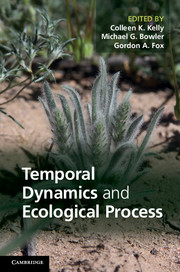Book contents
- Frontmatter
- Contents
- List of Contributors
- 1 Introduction
- Part I Observing temporal processes in nature
- Part II Application to specific questions
- 9 Evolution of synchronised and intermittent reproduction (masting) of trees: key role of regeneration dynamics
- 10 Spatiotemporal variation can promote coexistence more strongly than temporal variation
- 11 Roles of pollinator attraction and environmental fluctuation in inducing flowering synchrony
- 12 Temporal dynamics and the spread of insect resistance transgenes
- 13 Concluding remarks
- Index
- References
11 - Roles of pollinator attraction and environmental fluctuation in inducing flowering synchrony
Published online by Cambridge University Press: 18 December 2013
- Frontmatter
- Contents
- List of Contributors
- 1 Introduction
- Part I Observing temporal processes in nature
- Part II Application to specific questions
- 9 Evolution of synchronised and intermittent reproduction (masting) of trees: key role of regeneration dynamics
- 10 Spatiotemporal variation can promote coexistence more strongly than temporal variation
- 11 Roles of pollinator attraction and environmental fluctuation in inducing flowering synchrony
- 12 Temporal dynamics and the spread of insect resistance transgenes
- 13 Concluding remarks
- Index
- References
Summary
Introduction
Masting, or mast seeding, is the synchronous seed production in certain years by a population of plants (Kelly 1994). The reproductive activity of plants in forests often fluctuates considerably between years, and flowering and fruit production are synchronised over long distances (Koenig and Knops 1998, 2000, Koenig et al. 1999).
Mast seeding has clear disadvantages such as higher density-dependent mortality of seedlings and lost opportunities for reproduction (Waller 1979). In addition, field observations suggest that seed production fluctuates more than the level that can be explained by climate-mediated variation in resource availability (Büsgen and Münch 1929). Two major questions arise from ecological studies on masting: Why is masting evolutionarily favoured regardless of apparent disadvantages? How do plants allocate resources to realise variable flowering efforts in a way synchronised over different individuals?
A family of resource budget models that have recently been studied provides answers to both questions: on the physiological mechanism by which plants may successfully generate such intermittent and synchronous reproduction (Isagi et al. 1997, Satake and Iwasa 2000, 2002a, b) and on the conditions for which masting is adaptive (Rees et al. 2002, Tachiki and Iwasa 2008). Resource budget models assume that plants accumulate resources every year and set flowers and fruits at a rate limited by pollen availability when the stored resources exceed a reproductive threshold level. The model predicts that individual plants flower intermittently when their resources are depleted after heavy flowering and fruiting, and that synchrony emerges in self-organised fashion by coupling through the need to receive outcross pollen from other plants (Satake and Iwasa 2000).
- Type
- Chapter
- Information
- Temporal Dynamics and Ecological Process , pp. 251 - 281Publisher: Cambridge University PressPrint publication year: 2014



